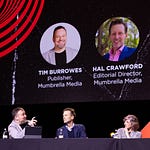Welcome to The Unmakers, Unmade’s latest podcast series where we talk to people who are trying to remake the media and marketing world.
Each episode will feature people who are doing business differently. We're going to meet the startups, the troublemakers, and the dreamers who've looked at the communications industry and are trying to find a better way.
If you're an unmaker with a story to tell about how you're changing the media and marketing world, we’d love to hear from you on letters@unmade.media.
In today's first episode, Tim Burrowes talks to the founders of Mutiny, Henry Innis and Matt Farrugia. After leaving big network jobs, they chose not to simply start yet another agency. Instead, they launched a software company which helps marketers understand the return on investment of their media spend.
Rather like Google analytics helps marketers to understand their digital activity, Mutiny attempts to do the same for marketing investment using the data that brands put into it.
Mutiny's been around for more than three years, and a few days ago, it closed its first seed round with investors putting in $2.4m to help take the company global. The deal valued Mutiny at more than $10m.
Tim caught up with Henry and Matt in Melbourne a few days before the announcement.
Below is the full transcript of the interview. Today's episode of The Unmakers was edited by Abe's audio.
And don’t forget, Unmade is offering 55% off an annual subscription to a paid membership of Unmade. That reduces the $650 price down to $292.50 per year. It will never be as low as this again.
Transcript
Tim Burrowes: I'm Tim Burrowes from Unmade. Welcome to The Unmakers, a series in which I talk to people who are trying to remake the media and marketing world. Each episode, I talk to people who are doing business differently. We're going to meet the startups, the troublemakers, and the dreamers who've looked at the communications industry and are trying to find a better way. If you're an unmaker with a story to tell about how you're changing the media and marketing world, I'd love to hear from you. Email me at tim@unmade.media. Before you remake it, you've got to unmake it.
In today's first episode of The Unmakers, I talked to the founders of Mutiny, Henry Innis and Matt Farrugia. After leaving big network jobs, they chose not to simply start yet another agency. Instead, they launched a software company which helps marketers understand the return on investment of their media spend. Rather like Google analytics helps marketers to understand their digital activity, Mutiny attempts to do the same for marketing investment using the data that brands input into it. Mutiny's been around for more than three years. A few days ago, it closed its first seed round with investors putting in $2.4m to help take the company global. The deal valued the company at more than $10m. I caught up with Henry and Matt in Melbourne a few days before the announcement. I began by asking Henry what this moment will mean for the business.
Henry Innis: What we had set out to do over the past two to three years was we obviously started the business where it had a look and feel of a consultancy. We always set out with the plan to have SaaS and technology products at the heart of that.
Tim Burrowes: SaaS being software as a service.
Henry Innis: Yeah. So, and we proved out a SaaS model with some fairly large enterprise customers who have renewed a number of times. For us now, the key focus is how do we build what you would describe as a bottom-up SaaS model. So, a SaaS model which is, one, driving growth through its own product, and two, it's able to deliver value increasingly in a very automated way, both to our customer base but also to their agencies. This allows us to build tools on top of the platform that don't just do the core of marketing ROI, but also integrate back into agency workflows and also customer workflows more effectively.
Tim Burrowes: Well, we'll get into the model and also the fundraising a little bit more. First, I guess the headline description of what mutiny offers is an ability for marketers and agencies to see how their media spend is being used most effectively.
Henry Innis: Yeah, it's the best, we call it marketing investment analytics. So, in the same way that every single business has Google Analytics for their website and that is the primary form of measurement that you have within the marketing space, we envisage the same thing coming against your marketing pricing media going forward. So, marketers will install a platform that acts as a marketing investment analytics platform across all of their activities and allows them to see financial returns.
Tim Burrowes: Well, we'll get into that properly in a moment. Matt, let me come back to you then. Let's do the origin story. Where did the two of you get together then to build Mutiny in the first place?
Matt Farrugia: So, Henry and I met at WPP, I think it was around 2017 or thereabouts, and I was managing director of Y&R Creative Agency and also worked with a group across WPP, various clients at the time, and Henry was our national strategy director, and we struck a kind of natural working rhythm and a shared interest in real disruption for doing things differently and better, and also shared a frustration with a lack of speed to things like speed to insight and also evolving capabilities. So, then through that shared frustration, I guess, we thought, "Hey, let's go and start our own disruption and call it Mutiny."
Tim Burrowes: And it's still fairly unusual for people who've got big network jobs to actually make the jump because you're quite well paid, there's not too much risk. Was it the opportunity in front of you or was it frustration in the world you were in? What actually propelled you out the door?
Matt Farrugia: Great question. I probably put it to I became uncomfortable with being too comfortable, and I think those environments are really set up for you. We have to again, great environments for many people. You can build your careers in those networks. I think I was interested in looking beyond that and outside of those networks in terms of to create real change takes a level of risk, and also Henry and I set out to create something of real value, and the product that we have in market today, it didn't exist. The type of product we have today didn't exist. So, I think we just found that so incredibly exciting, and I think you hear of a lot of stories of large enterprise wanting to create new products for their customers, be it massive telcos or banks, whatever. It's a struggle. To create a new product, creating new value or tapping into white space as it's called, it the best way to do it is go and acquire a company who's doing it, or create a complete skunkworks team outside of that company to build that product. Yeah, do you know what I mean?
Tim Burrowes: Well, Henry, let me bring you back in on that point. What you have now as a product, how close is that to what you had in the back of your mind when you first made the leap? Because I honestly thought you were adding a bit of a bit of sizzle to it, but basically you were starting another agency, and it took quite a while for the penny to drop for me that really, you're a software company.
Henry Innis: Well, so I've always had a background in software. So, I think that's first thing is that Matt's had a background in avionics engineering. We both understand problems from an engineering and systems mindset. So, I think that helps. When we started, we looked at it through one of two lenses. Either we were going to be a consultancy, but we were going to use technology to attack the pricing structure really, really well. So, by way of example, you might do a consulting-style project, but at a much cheaper fee, much less head hours because you had something producing the outputs much cheaper. The alternative was pure placed SaaS, but either way, we were going to be reliant on some kind of technology product at the core from the very start of the business.
I think the penny dropped for us that we were going to go down the SaaS route when we started seeing usage numbers. So, where people were coming into the platform, largely without us necessarily having to supervise and handhold, and that's where we started to go, "Well, this is really leaning a lot more towards SaaS." We weren't sure, being honest, which way it was going to go, just because of the nature of some of the industry. It is used to having a lot of support structures around it. But I think we decided about six months in when we started seeing some of those early numbers to do that. The other strength I think of SaaS is it actually allowed us to work better into the ecosystem because what we don't really want to do is you don't really want to replace the ingenuity of a media agency or a really good media agency planner because you can't replace that with data. The same goes with groups like creative agencies and things like that.
So, I think one of the good things about being a SaaS product is you can build for both the agency and the customer and that helps, and versus if I'm one of our competitors, they bring in consultants and it's a bit off-putting, I think, to agencies to have an army of consultants sitting there critiquing their work in PowerPoint. I mean, I wouldn't really like that, whereas for us, it's a bit like installing Adobe or something similar. So, I think for us, that's why we focused on SaaS and those sorts of elements. Also, just think SaaS is more fun as a kind of something to execute.
Tim Burrowes: Well, also presumably much more scalable as well. Well, I guess, talk about that sort of what it contributed to kind of the speed of the business's growth and everything. Let's just drill in a tiny bit into the product itself. I guess some of our listeners from a hardcore martech background will have a pretty clear picture. Others won't. If you were describing this in the pub, what is the problem that you're helping solve?
Henry Innis: Well, I think, firstly, every marketer has more decisions than ever to make. We're not looking at decisions, shrink number of decisions shrinking. We're looking at number of decisions growing. The only platform at the moment that helps you make those decisions from a data-driven perspective realistically is website analytics. That's about as close as we get which is why everything has been so digitally skewed, and also because the data around digital is timely and it's provisioned in a format that's accessible, and it's quick and easy for an average person to use. For us, we believe that the orientation of the market around website analytics basically has, I don't want to say stuffed marketing, but it kind of has. What we are building is marketing investment analytics. So, a true, actual end-to-end analytics platform across your growth that sits across everything.
Tim Burrowes: So, Matt, could you think of a good sort of hypothetical example of a decision that would be changed by using the product or it might be?
Matt Farrugia: Yeah. No, great question. There are so many, and I think we're seeing a lot of use cases from our customers using the platform, and the decisions, we're seeing a lots of different types of decisions. The ones that we didn't anticipate, how they were using the platform, but I'd say the one would be relocating budget across channels that are underinvested that can deliver a greater impact. So, for example, we've had customers shift, they've identified $800,000 of budget for a particular campaign, and they were able to reallocate that with a high degree of accuracy into other channels that were underinvested, that the platform indicated if they moved this budget across these channels, they would get this.
Tim Burrowes: And how specific are we being with channels? Is it just like, okay, if you move from, I don't know, magazines to newspapers, to use two old school examples?
Matt Farrugia: That is an example. We can get down to the level of shifting budget across channels. So, for example, from online video to out of home, etcetera, or even to at a geography level, across publishers, across creative types, and also formats of advertising. So, a level of granularity that to do that previously, it took a hell of a long time, a hell of a lot of data, and really heavy on resources to determine that, where our platform now can deliver that insight to inform that decision in seconds.
Tim Burrowes: And which of the agency groups have supported you now? Are all of the major holding companies involved?
Henry Innis: We work primarily with customers.
Tim Burrowes: So, mostly, it's brand side, as opposed to agency side.
Henry Innis: Brand side are the people that will commission the contracts, yes.
Tim Burrowes: Interesting.
Henry Innis: So, we certainly go direct, but we have a number of various, I mean, you'd say across most of the majors, we probably, we have some level of interaction. I'd also just say most of them are pretty good at provisioning the data as well. They know what to give us and all those sorts of things. So, it's been pretty successful like that. We generally see once it's installed, again, I draw the analogy to Salesforce and Adobe. A customer normally install Adobe Analytics or something like that, and then following that, the agency will then start to use them and all those sorts of things as well. So, they'll come together and coalesce around a platform. I think for agencies, it can be quite good because they're not kind of marking their own homework in a sense, and so there's an independent platform where both the customer and the agency can come around and go, "Well, here's what we did working, and if not, why not?" and start to make those decisions in a fairly impartial kind of way.
Tim Burrowes: And, Matt, how do you and Henry divide your labour? Who does what between the two of you as co-founders?
Matt Farrugia: Good question. I think Henry spends a lot of time with the product and engineering team. I think that's where his strengths definitely lie, and I think and I spend a lot of my time with our customers and guiding them to how to get the most out of platform and how to see value and help them, educate them how to make those decisions that we're talking about, and then there's a whole bunch of operational stuff that we kind of share, but yeah.
Tim Burrowes: Now, one of the side jobs to the main job recently has been doing a fundraising round which is a massive job in its own right. So, this would be, I suppose, if we talk about kind of preseed, seed, round A, the sort of size of the round of fundraising you're doing would be a seed round, presumably sort of $1 or $2m, something like that you've raised?
Henry Innis: $2.4m.
Tim Burrowes: $2.4m, and how will you spend it?
Henry Innis: So, right now, I mean, there are a few factors that dictated why we raised. Right now, we've kept our burn roughly flat. We're not on a kind of a runway type model which must…
Tim Burrowes: Yeah, so you weren't highly profitable but you weren't losing money in other words.
Henry Innis: Correct, yeah. We hadn't really burnt significant amounts of capital and things like that. So, we weren't on a runway model or anything like that, but we wanted to move into two areas. The first is moving in and starting to data mine insights and things like that, just to make finding some of the areas a little bit easier and more responsive for our customer base and for our user base. That drives usage up for us and also just starts to get us into the workflows. The second is doing a lot of workflow integration. So, getting back into Slack, Teams, all those sorts of things, building links back into those areas. Again, the reason why is to build a stickier product. And then the third is to start to release data management tools on the other end of the funnel to make the whole process of data collection organisation easier, and we just want to basically make that free and make that the standard of how people collect and manage enterprise marketing data.
We think that managing enterprise marketing data is a really hard and challenging thing for most organisations at the moment. We look a lot to a business called Dovetail who does the same thing in UX research, very, very large business now and very successful business. The way that they built a repository around UX research, we want to try to build the same kind of repository for marketers to use and manage that data. If we do those three things, we'll have, one, made managing data far easier, more effective for the market which is just good for us in the category generally. The second thing is we'll have provided a lot more value to customers through really strong usage based value, automated value creation products as well. And then the third thing that we'll have done is we'll have integrated far more into the workflows and the daily workflows of our user base than before.
I think it's important to note our entire organisation is KPId on usage of the product. So, none of us are actually KPId on renewal of contracts and things like that. That's important to us, but the really important thing to us that we know matters is usage. If people are using our product, they're loving it, and therefore they'll renew. The same goes for kind of any other kind of business performance you look at. So, I think it's a very software way to view the world, but this raise allows us to continue to align to that and to invest in R& D in those spaces.
Tim Burrowes: And what sort of people have invested this time round? What sort of backgrounds?
Matt Farrugia: Yeah, varied. I guess we're quite humbled by the investors that have come in, and they do vary from being CEOs and chairpeople of very large organisations locally and globally. There's CEOs, former CEOs of very large media companies. There's some founders of some very successful product tech-focused companies. We're excited by the group of people that are getting on board and believing in our product and getting onto the journey.
Tim Burrowes: And are there any names you are allowed to share at this stage?
Henry Innis: Well, we certainly had some really great support, so I mean, the names, I mean, there are names like Brodie Arnold who's the chairman of iSelect, he'll be joining our board, and Charlie Gearside, he was one of the co-founders of Eucalyptus. Alexey Mitko as well who's a co-founder of Eucalyptus. We have Sir Robin Miller from the UK who was former CEO of Emap and chairman of HMV. And then also we had a UK quant fund Bloomsbury Information Capital who anchored the round effectively for us. So, most of our existing investors also followed their money which obviously helps and is a really good sign. So, we're pretty lucky that we feel we've found the right mix of technology, media, marketing leaders, and also just business leaders. You've also got a lot of people, we've been lucky to have Chris Savage people like John Curtius and other kind of those sorts of that sort of era as well.
Tim Burrowes: And I think earlier in your life, before he went off to another gig in Asia, you had Cheuk Chiang on your board or CEO.
Henry Innis: I think Chewy pursued other avenues which potentially were better suited to what he wanted to do.
Tim Burrowes: For those who aren't really familiar with how these sort of raisings were, you kind of go preseed, seed, like you're planting a seed, and that's with the view to becoming big. Matt, how big can you get?
Matt Farrugia: Sky's the limit. I think if we look at demand, we're sensing a lot of demand coming from other markets, including the US, and I think in terms of how big we can get, I think it's probably not just the amount of employees we are. It's probably the volume of media inventory money that's coming through the platform is what we are really interested in as well.
Henry Innis: The way you can do it is that you can look at there are 150,000 businesses in the US who are able to get this product. If you were to assume a 10% conversion rate, so you get to about 10% market share. So, it's 15,000 businesses in the US. There are over 1,000 businesses in Australia. Again, you do the same maths. We estimate that the category itself could be somewhere in the orders of $10b plus. For us, we envisage that various players within the market could be taking up to $500m in recurring revenue.
Tim Burrowes: And what's your pricing structure? You kind of alluded to the fact that there's a kind of entry level free level. Where do you go from there? What points do the businesses start paying and how?
Henry Innis: Well, so there are two conceptual models in SaaS at the moment. Model one is what most people would be familiar with which is enterprise SaaS where you go in, you negotiate big contracts, and things like that, and to an extent, I think that's where we have traditionally been as well.
Tim Burrowes: And that's usually priced on the number of users for instance?
Henry Innis: No, so, well, it can be, but it's priced on a license for the enterprise and seats and features basically. Where we want to get to is primarily pricing against I would say usage and value. So, we want to be able to collect the data and do that data management piece largely for free. Then if you'd like to switch on the unified WarChest model which is able to model all of your data very quickly and effectively, that comes at a cost, but it can reliably deliver this result. Then on top of that, we then want to have pricing structures that exist around if we see a low ROI channel, able to data mine recommendations around that channel and provide that to get it from A to B and basically give people that confidence, or if there's a low performing brand or business unit, same again.
Henry Innis: I think for us, it's important to note, we're not there yet. This raise gets us to that sort of model, but for us I think as a business, we want to be pricing around where value is created, not where reports are generated and things like that because ideologically for a business that gets us much closer to customer value, and again, I come back to that concept of usage and things like that. If you're constantly priced against usage, you're constantly incentivised against usage, and if you're entire business thinks about usage and workflows, then your entire business will be more in sync with your customer base than ever which is dangerous in tech if you're not doing that
Tim Burrowes: Now, I guess you must have quite a nice sort of network effect as well, where the more data you get into the system, the more you mine, the more information you get. Matt, I guess when you're talking to customers, one of the objections you must get is well, what about protecting my data. How do you make sure that you kind of keep ward off each individual client's information and data? How do you reassure them about that?
Matt Farrugia: We've tested out that. So we adhere to very strict standards around data security, information security, network architecture security, etcetera. I think the key thing there is data segregation. We have our engineers and our entire architecture is configured. When we roll out what we call an instance of WarChest for a customer, we have very, very well defined architecture that drives and manages what we call data segregation. There is no crossover of data. If there is, our automated notification systems just light up, and ultimately, that's the assurance and confidence we give our customers. We work with many customers across many categories, including banking, and finance, and retail and every other, all the other major spenders within advertised media. Australia especially has one of the higher standards and most strict requirements around things like compliance and security.
Tim Burrowes: And of all of the insights that you've generated, just give me one really great example, "Oh, blimey, okay, that's interesting," where you'd never have thought that about the ROI of a particular channel, for instance. Henry, you look like you thought of one. You certainly leaned forward at that point.
Henry Innis: So, well, I think there are two, one, out home is incredibly cyclical. So, one really interesting thing I think is that we see the effectiveness coefficients or what you call the time varying data of out of home varies across seasons, particularly it's obviously affected by the weather, but our working theory is, for example, shorter days equals shorter exposure times. Right? So, the actual amount of daylight has a direct effect on at home viewability as it were.
Tim Burrowes: Even with digital outdoor, for instance?
Henry Innis: Well, I think most digital outdoor, it's still not a dominant part of it. Right? So, I don't know if that would change with digital outdoor. It might, but that's an interesting one that we've picked up. Right now, we're exploring how long a Facebook scandal will impact effectiveness for Facebook.
Tim Burrowes: Oh, that's interesting.
Henry Innis: That's something we're exploring in.
Tim Burrowes: What's the early information on that one?
Henry Innis: Stay tuned, and I think the next thing, the other kind of interesting areas that we look at is one thing that's quite consistent is sometimes certain channels will have low ROI in a system, but that doesn't necessarily mean that they're bad. Sometimes it actually means they're underinvested. So, by way of example, some customer bases will maybe spend 5,000 or 10,000 in TV or 5,000 in TikTok or something like that, these quite visual mediums, and they tend to perform quite poorly. Why? Because they actually need a certain amount of weight. If I buy one TV and it gets lost in the noise versus if I buy 500 TV ads in a week, suddenly everybody remembers me. It's like Harvey Norman. Right? Everyone knows a Harvey Norman ad.
Tim Burrowes: So, where would be the very last place you would spend your last thousand dollars based on everything you've seen?
Henry Innis: Oh, it's a really dependent question on the actual business itself. So, I'll give you a really good worked example of this which is like search is a really funny platform to be in. Unless you have one of two factors, it's hard to make money in search, well, make profits in search, unless you've got two things. Right? One you've got to have a better operating margin. So, if you have a better operating margin, you can outbid other people effectively, and search works amazingly to drive ROI in that kind of case.
Henry Innis: The second is if you have no competition. So if you have no competition in search again, it's an amazing place to be. So, those are the two vectors in which you look at search, but if I've got three companies, all who can pay up to a hundred dollars each for a customer, and then I'm in Google's ad bidding system, every company will basically bid away each other's margins in the auction system within search. So, I'd say search is a really interesting example of how it's brilliant in some context, but there have to be really clear dynamics on which it works to drive high ROI versus how people conventionally think about search which is as the kind of last element of it. It's very often it needs, there's certain dynamics you need.
Tim Burrowes: Interesting. Now, obviously you're still quite early in the journey, but equally, once you start doing fundraising rounds, you have investors who are investing to see a return down the track and they want some pictures on the potential exit. What's the likely exit for you guys? Is it to get acquired by someone? Is it to float as an IPO? What are the options, do you think?
Matt Farrugia: Good question. I think there are options. Right now, our focus is on in building our product and evolving our product roadmap. There is absolutely a complete obsession about our product and usage as Henry mentioned earlier. So, I think while an exit down the track of sorts might be there, right now, our focus and attention is actually just continuing.
Tim Burrowes: And where would you naturally sit in an exit? Would it be with like a, I don't know, an Adobe or something like that, that already has a stack, do you think?
Henry Innis: There's probably three to four categories of buyers that you think about. I think one thing I'd just say is we're enjoying building this business way too much to think about an exit. I think if you'd asked me three years ago, I probably would've had an exit in mind. These days, I think it's too much fun. So, I think that changes your calculus a bit, but I mean, your buyers are probably more in the data, analytics and business analytics space, I would say. So, I'd say groups like the S&P and those sorts of groups, or Bloomberg, tho those sorts of companies, I'd say, far more than an Adobe or far more than a Facebook or a Google, and there's a reason why, because those platforms have execution built into them, and because you're trading on their systems or trading on their rubric and things like that. There's a natural conflict if they acquire us so it's a little bit more difficult, and that's also why it's more difficult for them to enter our space as well.
Henry Innis: So, those two things kind of work hand in hand. It's strategically hard for them to enter our space. That's why they haven't done it, or they haven't done it successfully at scale, but it also means that our buyer profile probably sits more towards that business intelligence group, but that's a long way off too. That's a long way off.
Tim Burrowes: No, maybe might be the last question. Matt, I'll come to you first on this one. From the outside, this looks like a story of just like a rocket ship taking off. One of the realities of any kind of startups is never actually like that inside? You're zigging and zagging on the upward line. What's been hardest?
Matt Farrugia: Yeah, good question, Tim. If I think about what's been the hardest, at the same time, the hardest had been the most rewarding. So, I think in the early days, Henry and I wore many hats. We kind of still do. One day I would be the customer lead, the legal council, the payroll manager, looking at cashflow.
Henry Innis: You still are.
Matt Farrugia: Yeah, thanks Henry. Yeah, and then the table tennis champion, but that's another story. So, I think, look, yeah, coming from large companies, I think anyone, when you get into a... Startups are not for the faint-hearted. They really aren't. Your risk appetite, you've got to be brutally focused on the vision and where you are heading and the potential and maintain that belief because the second that you let those little whatever you want to call them, the thoughts around negativity or the thoughts around that risk that's going to weigh you down that, oh, maybe we shouldn't do this, there's no point in going forward. You're not going to be cut out for it. So, I think the hardest bits were not having that complete support team around you like you did in a larger company. As we're growing, we're filling those gaps, but yeah, that's probably...
Tim Burrowes: And Henry, what have you found the hardest?
Henry Innis: Startups, you have to just be extremely resilient, and you have to effectively try to take every knock. I think the most important thing and the hardest thing is even if things aren't going your way, you've got to project an immense amount of confidence to everybody around you, and that's the hardest thing, I think. I think giving security and certainty to others in a very uncertain environment is a challenging thing to do and project, and it's a challenging thing to do mentally. You have to compartmentalize a lot. You have a lot of stress associated with that you can't let through, and that also creates a high degree of loneliness as well I'd say. So, I think the one thing I know is that certainty and confidence in decision-making and a decision, even if it's not perfect is better than no decision.
Henry Innis: Those sorts of things are really important characteristics to bring through. And so, one of the things day in day out is providing that certainty, that confidence, even when you are feeling at your lowest, and I think that is the hardest bit that nobody talks about is providing that certainty, shaping that certainty, giving that confidence to people around you so that you are able to tackle big problems, big industry issues, big fires and all that kind of thing, do so with a focus and a clarity.
Tim Burrowes: Well, it's going to be really interesting from where I'm sitting watching what you do next. So, Matt and Henry, congratulations on the fundraising and thank you very much for joining me.
Henry Innis: No problems.
Matt Farrugia: Thanks, Tim.
Tim Burrowes: Thanks for listening to The Unmakers from Unmade. If you're an unmaker, I'd love to talk to you. Email me, tim@unmade.media. Today's episode of The Unmakers was edited by Abe's audio. I'm Tim Burrowes. Before you remake it, you've got to unmake it.














Share this post